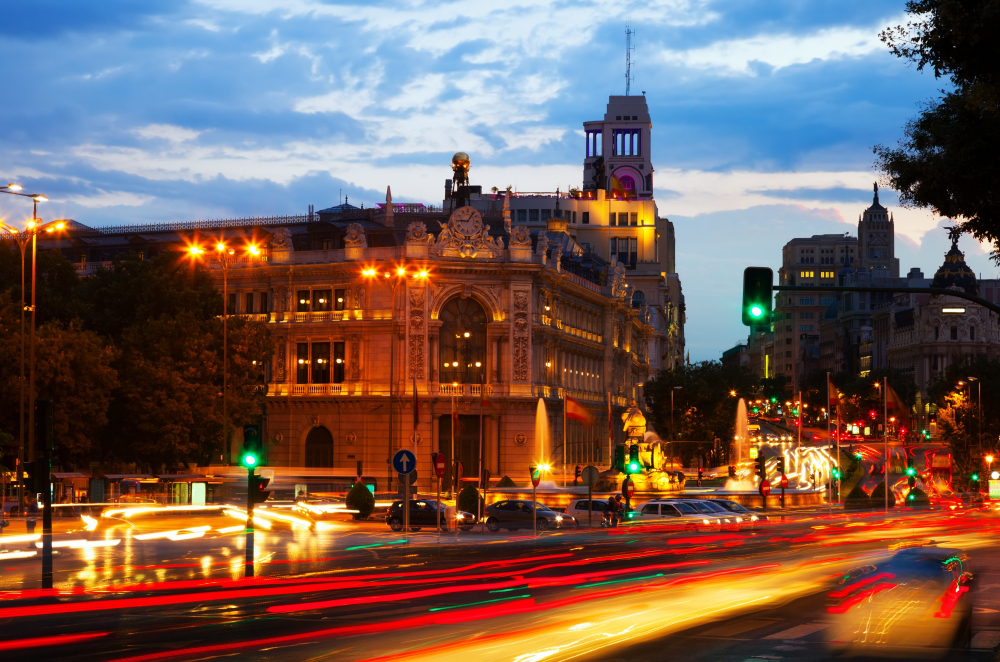In today’s dynamic business world, effective management of shared workspaces has become an essential skill to ensure the productivity and well-being of professionals. In cities like Madrid, where competition and innovation are the order of the day, knowing how to make the most of coworking spaces and shared offices can make a big difference.
The COVID-19 pandemic accelerated the adoption of remote work and highlighted the need for versatile workspaces that can adapt quickly to changing circumstances. This shift has led many companies to rethink their real estate strategies in favour of more flexible solutions such as coworking spaces.
Business centres in Madrid have adapted to this new reality by offering options that meet the specific needs of each client. For example, meeting room rental in Madrid is an excellent option for companies that need a professional venue for one-off meetings or events without making a long-term commitment. Likewise, the rental of offices in Madrid allows entrepreneurs and small companies to have a private and professional workspace with total flexibility.
In this context, effectively managing a shared workspace involves much more than simply having tables and chairs. It requires meticulous planning and constant attention to the needs of users. From the layout of the furniture to the implementation of advanced space management and security technologies, every detail counts in creating an environment that fosters productivity and collaboration.
In the following sections, we will explore some of the best practices for effective management of these spaces, highlighting how a user-centred approach and proactive management can transform a shared space into an engine of innovation and business success.
We will look at key aspects such as contract flexibility, available equipment, the importance of networking and additional services that can make a difference to the user experience.

The importance of proper management of shared workspaces
The importance of proper management of shared workspaces lies in their ability to maximise the benefits while minimising the challenges inherent in such environments. First, it is essential to recognise the many benefits that these spaces offer.
Shared workspaces encourage collaboration and networking between professionals from different sectors, which can lead to unexpected business opportunities and synergies. They also provide a flexibility that is difficult to find in traditional office rentals. Entrepreneurs and small businesses can access high-quality infrastructure and services without incurring the high start-up and maintenance costs associated with an office of their own.
However, to make the most of these benefits, the management of these spaces must be meticulous and tailored to the needs of their users. Efficient management of a shared workspace involves careful planning of the layout of the space, ensuring that each area is optimised for different types of work. This ranges from quiet zones for tasks that require concentration to common areas where interaction and creativity can flow freely.
However, managing shared workspaces also presents significant challenges. One of the main challenges is maintaining an appropriate balance between privacy and community. While some users may enjoy the dynamic and collaborative environment, others may find it distracting and not conducive to productivity. Therefore, it is crucial to have a variety of spaces and configurations that meet these diverse needs.
Another important challenge is the management of shared resources. Equipment such as printers, meeting rooms and breakout areas must be available and in good working order at all times. The implementation of efficient reservation systems and regular maintenance are essential to avoid conflicts and ensure that all users have equal access to resources.
Security is also a critical aspect in the management of these spaces. The integration of advanced technologies for access control and surveillance is essential to protect both users and their belongings. In addition, in the current context, hygiene and social distancing measures have taken on renewed importance, requiring rapid and effective adaptation by venue managers.
Proper management of a shared workspace also involves constant attention to user feedback. Listening and adapting to their needs and suggestions not only improves their satisfaction and retention, but also helps to identify areas for improvement and to innovate in the services offered.
Ultimately, effective management of shared workspaces is crucial to maximising their benefits and minimising their challenges. A user-centric approach, combined with proactive and adaptive management, can transform these spaces into highly productive and collaborative environments, benefiting everyone involved and contributing to the overall success of the businesses that use them.
Space planning and design
The planning and design of a shared workspace is a key element in ensuring that the needs of all users are met, thus fostering a productive and pleasant environment. The first step in this process is a thorough assessment of the needs of potential occupants.
This analysis should consider a variety of factors, from the type of activities that will take place in the space to the number of people who will use it on a regular basis. For example, a tech startup may require open areas that encourage collaboration, while a consultancy might need more private offices and meeting rooms.
Once these needs have been identified, it is crucial to translate them into a design that maximises the functionality and comfort of the space. This is where ergonomic design comes in, which focuses on creating environments that are not only efficient but also healthy for their users. Ergonomic furniture, such as adjustable chairs and height-adjustable desks, can make a big difference to daily comfort and productivity. The layout of workstations should allow for good circulation and accessibility, avoiding the feeling of crowding and reducing the risk of accidents.
Lighting also plays a vital role in ergonomic design. Making the most of natural daylight not only reduces energy costs, but also has a positive impact on the well-being and motivation of employees. Complementing this light with adequate artificial lighting, which does not cause glare or eyestrain, is equally important.
In addition, the acoustics of the space should be carefully considered. Using sound-absorbing materials and creating designated areas for calls and meetings can help minimise noise and distractions, creating a quieter and more focused working environment.
The design of the space should also include common areas that promote interaction and relaxation. Spaces such as kitchens, lounge areas and play areas not only promote wellbeing, but can also be key points for socialising and exchanging ideas between users, encouraging networking and collaboration.
In terms of technology, space planning must include an infrastructure that supports modern technological demands. This means having a robust Wi-Fi network, sufficient charging points and access to high-quality shared equipment such as printers and projectors. Implementing online booking systems for meeting rooms and other resources can also significantly improve the organisation and efficiency of the space.
Finally, flexibility is an essential aspect of shared workspace design. The ability to reconfigure areas according to the changing needs of users makes it possible to adapt quickly to new projects or changes in the composition of teams. Modular furniture and movable partitions are excellent solutions to maintain this flexibility without compromising the functionality or aesthetics of the space.
Clear policies and rules of coexistence
The implementation of clear policies and rules of coexistence is essential to ensure the smooth running of any shared workspace. In an environment where professionals from diverse industries and work styles coexist, establishing clear ground rules is crucial to maintain harmony and efficiency. These rules should be communicated explicitly from day one, preferably through a user guide or during an initial orientation session. Rules can cover aspects such as times of use of common facilities, meeting room reservation policies and proper management of shared resources.
It is equally important to detail expectations about the maintenance of the space. This includes cleaning work areas after use, respecting equipment and furnishings, and proper waste management. By establishing these guidelines, a sense of shared responsibility among all users is fostered, contributing to a more orderly and pleasant environment.
Fostering human respect is another essential pillar of coexistence within a shared workspace. Beyond the ground rules, it is vital to promote a culture of mutual respect and consideration. This starts with recognising diversity and inclusion, understanding that each individual brings a unique and valuable perspective to the work environment. Promoting empathy and understanding can help prevent conflict and build stronger relationships between users.
Open and effective communication is key to fostering human respect. Space managers should be available to listen to users’ concerns and suggestions, acting as mediators when necessary. Organising regular meetings to discuss issues of common interest and resolve possible misunderstandings can go a long way in maintaining a collaborative and respectful environment.
In addition, it is essential to establish a clear protocol for conflict resolution. While all users are expected to respect the rules and act with consideration, disagreements can arise. Having a transparent and fair procedure for dealing with these situations ensures that they are resolved fairly and quickly, preventing small problems from escalating into larger ones.
The use of visual signs and reminders can also be an effective tool to reinforce policies and rules. Signs reminding people to turn off lights when leaving, to clean up after using the kitchen or to keep noise to an acceptable level in common areas help to keep the rules present in the minds of users, making it easier to comply with them.
Organising team building activities and networking events can further strengthen the community within the shared workspace. These activities not only allow users to get to know each other better and build stronger relationships, but can also serve as a platform to reiterate the importance of rules of coexistence and mutual respect.
In short, clear policies and rules of coexistence, along with fostering a culture of human respect, are critical to the success of any shared workspace. By establishing clear rules and promoting open and respectful communication, an environment is created where all users can work productively and harmoniously, maximising the benefits of sharing a professional space.
Optimising the use of space
Optimising the use of space in a shared work environment is a crucial task to ensure that all available resources are used efficiently and that users can carry out their activities in a comfortable and functional environment.
To achieve this, it is essential to carry out continuous monitoring and analysis of space usage. This process starts with collecting detailed data on how and when different areas of the coworking space are used. Using technologies such as occupancy sensors and digital booking systems can provide an accurate picture of usage patterns.
This data can identify trends and areas that may be underutilised or, on the contrary, overloaded. For example, it may reveal that certain meeting rooms are constantly occupied while others are barely used, or that common areas become congested at certain times of the day. With this information in hand, space managers can make informed decisions to improve the layout and use of space.
The key to effective optimisation is to make adjustments based on this data. This may involve reconfiguring furniture to create more collaborative work areas if a high demand for such spaces is detected, or reallocating under-utilised areas to functions that need more space. It may also include implementing stricter reservation systems to ensure that shared resources are distributed equitably and efficiently.
Furthermore, adjusting the use of space based on data is not a one-time process, but a continuous cycle of improvement. It is important to periodically review the data collected and be willing to make changes when necessary. Flexibility is crucial, as user needs may change over time, and the space must adapt to these new realities.
Another key aspect is communication with users. Informing them about changes made and the reasons behind them not only helps to manage their expectations, but can also foster greater cooperation and understanding. Users who feel listened to and valued are more likely to adapt to new arrangements and use resources more consciously.
Incorporating direct feedback from users is also essential. Regular surveys and feedback meetings can provide a qualitative perspective that complements quantitative data, revealing aspects that numbers alone cannot show. For example, an area may be hardly used not because of a lack of need, but because its current design is not comfortable or attractive.
Ultimately, optimising the use of space not only improves operational efficiency, but can also increase user satisfaction and productivity. A well-managed environment, where each area is used optimally and adapts to changing needs, creates an atmosphere in which professionals can work more effectively and collaboratively.
Therefore, the combination of continuous monitoring, detailed analysis and data-driven adjustments, together with open communication and the incorporation of user feedback, enables shared workspace management that is not only efficient but also highly adaptable and people-centric. This ensures that the environment evolves with its users, always providing the best possible space for their activities.
Maintenance and cleaning
Maintenance and cleanliness of a shared workspace are important aspects of ensuring a professional and welcoming environment for all users. Implementing efficient cleaning routines is key to keeping the space in optimal condition. This involves establishing regular cleaning schedules that cover all areas, from individual workstations to common areas such as kitchens, bathrooms and meeting rooms.
Having a professional cleaning team that performs daily tasks such as emptying bins, wiping surfaces and restocking hygiene supplies contributes to a clean and healthy environment.
In addition, it is important that cleaning routines are tailored to the specific needs of the space and its users. For example, high-traffic areas may require more frequent attention, while less frequently used areas may need less regular but equally meticulous cleaning. Periodic deep cleaning is also essential, ensuring that all areas are disinfected and kept free of dust and allergens. In today’s context, where hygiene is more crucial than ever, regular disinfection of high-touch surfaces such as door knobs, light switches and keyboards should be a priority.
Equipment maintenance is another vital component for the smooth running of a shared workspace. This ranges from technology equipment, such as printers, computers and projectors, to heating, ventilation and air conditioning systems. Establishing a preventive maintenance schedule helps to identify and fix problems before they become serious failures that can disrupt daily work. For example, regular checks of printing and network systems ensure that they are always operational and available to users.
In addition, it is crucial to have a clear protocol for incident management. When equipment fails or needs repairs, users need to know who to contact and how to report the problem efficiently. A ticketing system or an incident management application can facilitate this process, ensuring that all requests are dealt with in a timely manner and that users are kept informed about the status of their requests.
The training of maintenance and cleaning staff is also a determining factor. Well-trained teams not only perform their tasks more effectively, but are also able to identify potential problems and take preventive action. Investing in the continuous training of these teams ensures that they are up to date on best practices and the use of cleaning and maintenance products and technologies.
User collaboration is also key to keeping the space in good condition. Encouraging habits such as keeping work areas tidy, cleaning up after using the kitchen or immediately reporting any equipment faults contributes significantly to the overall maintenance of the space. Creating a culture of shared responsibility where each user understands their role in maintaining a clean and functional environment is fundamental.
Effective communication
Effective communication is a key pillar for the success of any shared workspace, as it ensures that all users are informed, aligned and satisfied. To achieve this, it is essential to establish clear and accessible communication channels that allow users to interact with each other and the managers of the space in a seamless manner.
These channels can include digital platforms such as mobile apps, emails and instant messaging systems, which facilitate the exchange of information quickly and efficiently. It is also important to have physical notice boards and information displays in common areas where important notices, events and updates can be posted.
The choice of communication channels should be tailored to the preferences and needs of users. Some may prefer the immediacy of an online chat, while others may be more comfortable with detailed emails or face-to-face meetings.
It is vital to offer a variety of options to ensure that everyone feels included and can access information in the way that best suits them. In addition, it is useful to establish regular communication schedules, such as weekly newsletters or briefings, that keep everyone up to date with activities and changes in the space.
User feedback and suggestions are crucial elements for the continuous improvement of the shared workspace. Fostering an open and receptive culture where users feel comfortable sharing their opinions and proposals is essential. To this end, regular surveys can be implemented to allow users to express their ideas and evaluate different aspects of the space. It is also useful to have physical and digital suggestion boxes, where comments can be submitted anonymously, ensuring that all voices are heard, even those most reluctant to express themselves in public.
Feedback meetings, whether face-to-face or virtual, provide a platform to discuss directly with users their experiences and expectations. These meetings allow for a more personal and detailed interaction, where managers can clarify doubts, answer questions and elaborate on suggestions received. The key is not only to listen, but also to act on the feedback provided. Demonstrating that users’ opinions are valued and have a real impact on decisions and improvements to the space strengthens the relationship of trust and collaboration.
Transparency in communication is another vital aspect. Informing users about changes and decisions, as well as explaining the reasons behind them, helps to manage expectations and reduce potential frustrations. For example, if a meeting room needs to be closed for maintenance, giving advance notice and providing alternatives shows consideration and respect for users.
Finally, training and continuous development of the management team in communication skills is essential to maintain a clear and effective flow of information. A well-prepared team knows how to handle different situations, from conflict resolution to organising events and conveying key messages.
In short, effective communication in a shared workspace requires the implementation of diverse and accessible channels, a culture open to feedback and transparency in all interactions. By fostering an environment where information flows freely and constructively, it creates a more cohesive and satisfying community for all members, thereby boosting productivity and collective well-being.
Security and well-being
Security and wellbeing in a shared workspace are essential to create an environment where users feel protected and can concentrate on their activities without worry. Implementing robust security measures is the first step in ensuring peace of mind for all occupants. This includes installing access control systems, such as swipe cards or personalised entry codes, which ensure that only authorised individuals can access the space.
In addition, the presence of security cameras at strategic points provides constant surveillance, deterring potential criminal acts and enabling a rapid response in case of incidents.
Another crucial measure is to have trained security staff who can intervene in emergency situations and offer assistance to users when necessary. Conducting evacuation drills and having clear signage on escape routes and meeting points in case of emergency is essential to prepare everyone for possible risk situations. Equipping the space with fire extinguishers, fire alarms and first aid kits is also an integral part of a comprehensive safety plan.
The well-being and health of users are equally important in maintaining a positive and productive work environment. Fostering a healthy environment starts with the design of the space, ensuring that there is sufficient natural light, adequate ventilation and green areas that contribute to a pleasant atmosphere. The ergonomics of the furniture plays a vital role; having adjustable chairs and height-adjustable desks helps prevent health problems related to posture and sedentary lifestyles.
Promoting healthy habits among users is also essential. This can include organising activities such as yoga classes, active breaks and talks on wellness and nutrition. Offering healthy options in vending machines and rest areas, as well as making drinking water easily accessible, encourages a balanced diet and adequate hydration.
Stress management is another essential aspect of wellbeing. Creating breakout spaces where users can relax, socialise or briefly disconnect from their daily tasks helps to reduce tension and increase productivity. In addition, the availability of services such as psychological support or mental wellbeing programmes can be of great help to those in need of additional assistance.
Hygiene is another critical component of wellness. Keeping the space clean and disinfected is essential to prevent disease and create a healthy environment. In the context of the pandemic, following strict cleaning and disinfection protocols, especially in high-contact areas, has become more important than ever.
Flexibility also contributes to well-being. Allowing users to adapt their schedules and choose the spaces that best suit their individual needs promotes a better work-life balance. This flexibility can significantly improve users’ overall satisfaction and well-being.
Finally, listening and responding to users’ needs is essential to maintaining their well-being. Gathering regular feedback and being willing to make adjustments to policies and services based on their comments ensures that the space evolves according to the expectations and requirements of those who use it on a daily basis.
Conclusion
Effective management of shared workspaces is a complex but essential task to ensure that these environments become true engines of productivity and collaboration.
From planning and ergonomic design to the implementation of clear policies and coexistence rules, every detail counts in creating an environment that is not only functional, but also welcoming and stimulating. Effective communication, both in transmitting information and receiving feedback, plays a crucial role in maintaining the harmony and efficiency of the space. Likewise, the safety and well-being of users are fundamental pillars that must be addressed with rigorous measures and a holistic approach to physical and mental health.
The key to success lies in a careful balance between flexibility and control, allowing the space to adapt to the changing needs of its users without losing sight of the structure needed to maintain order and efficiency.
Technology and data analytics offer valuable tools to monitor and adjust the use of space, ensuring that every square metre is used optimally. But beyond tools and strategies, the human factor remains central. Listening to users, understanding their needs and creating a culture of respect and collaboration are elements that cannot be replaced by any technology.
Ultimately, a well-managed co-working space is one that manages to create a vibrant and dynamic community, where professionals from different backgrounds can interact, learn from each other and grow together.
This environment not only fosters innovation and creativity, but also contributes to the overall well-being of its occupants, making them feel valued and supported in their working day. At Ibercenter, we strive daily to achieve this vision by providing spaces that not only meet expectations of functionality and comfort, but also inspire those who use them to do their best. We firmly believe that by focusing on people and their needs, we can create work environments where everyone, without exception, can thrive and achieve their goals.






